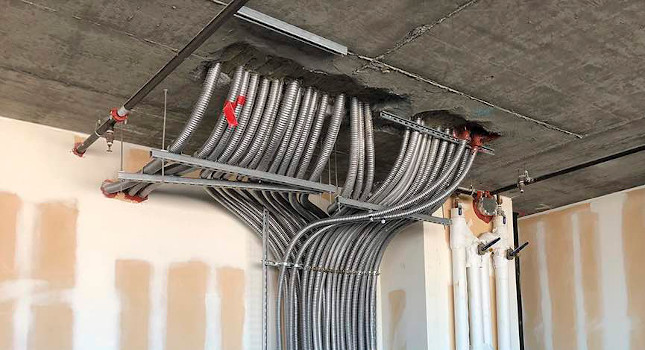Electrical engineers may consider using a raceway system for the electrical feed

For commercial office applications or other areas where remodeling or reconfiguring of the space may be more prevalent, the consultant should consider specifying the branch circuit conductors be installed within a raceway system from the power panel to an accessible ceiling space near the areas where the branch circuit loads are located.
At this accessible ceiling area, a junction box can be used to transition from the raceway system to a manufactured cable assembly, such as MC cable for the individual connections to lighting fixtures, switches and power receptacles. Raceways should also be considered for low voltage data cabling due to changes in network technology requirements from CAT-5e to CAT-6 — or even future CAT-7 upgrades. Note that category data cable cannot be spliced per Electronic Industries Alliance/Telecommunications Industry Association standards.
Buildings intended for multitenant use are another example of a good application for raceway and conductors. The landlord will either provide raceways only at landlord cost, with conductors provided by the tenant at tenant’s cost or the landlord will provide both raceway and conductors at landlord cost. During the design and construction of the building shell managed by the landlord, raceways or raceways and conductors can be routed from the landlord’s base building electrical rooms to respective tenant spaces.
Where a raceway only is provided by the landlord, it allows for a pathway for the tenant to pull its conductors from the space to the landlord’s base building electrical room. This creates a pathway and allows conductors to be routed after shell building construction without impacting the landlord’s finished spaces that the raceways traverse. During future tenant remodels, the landlord may have a tenant that requires a larger power feed, assuming the raceway was initially sized large enough, this can also be accommodated without invasive demolition to landlord finished spaces.
In food service applications such as restaurant kitchens, bars and/or service stations, it is fairly common to encounter changes in equipment either during the design/specifying stage, initial construction phase or even in a subsequent remodel or equipment replacement upgrade that incur changes in the branch circuit configuration. Some of the common equipment changes impact the use voltage, which can vary from 120 to 208(240) volts or 120/208(240) volts and single-phase versus three-phase configurations. Each of these changes impacts the wiring configuration provided to the equipment connection point.
One can also run into equipment changes where the use voltage remains as specified, but the equipment load increases in ampacity incurring a change to the branch circuit requirements. For instance, an equipment change from requiring a 20-amp, 120-volt circuit to 30-amp, 120-volt circuit would impact the conductor size from #12 AWG to #10 AWG. The consultant may consider specifying a raceway system due to these types of possible equipment changes between various ampacity, voltage and neutral connection requirements.
As stated previously, if the installation for this food service equipment is connected using a manufactured cable assembly and there was an equipment change that impacted the branch circuit requirements as described here, the only solution to changing the branch circuit is to completely remove the manufactured cable assembly and reinstall the correct manufactured cable assembly. This is likely fairly invasive and may require the opening and repair of finished walls and ceilings. With a raceway system, the wiring can be changed out without the need to open walls and ceilings, as long as the raceway is adequately sized.



